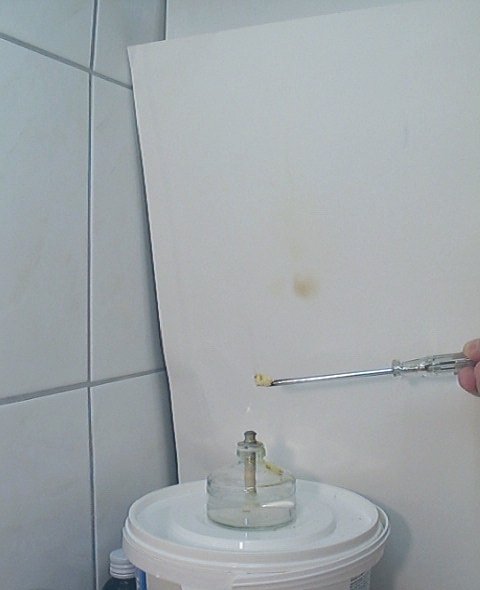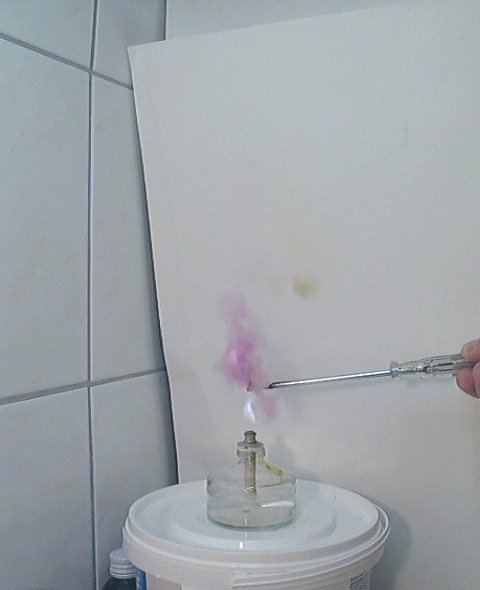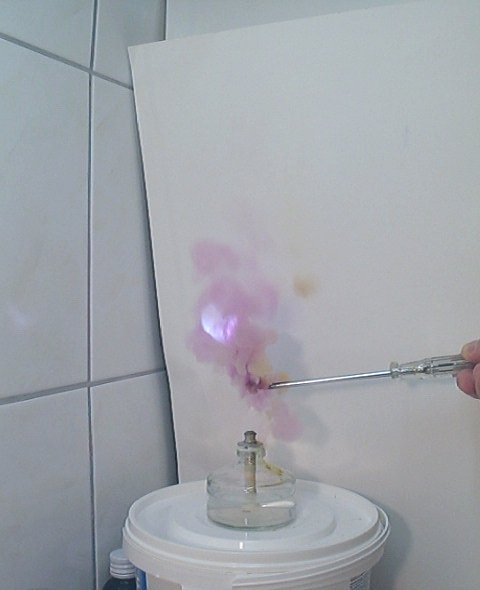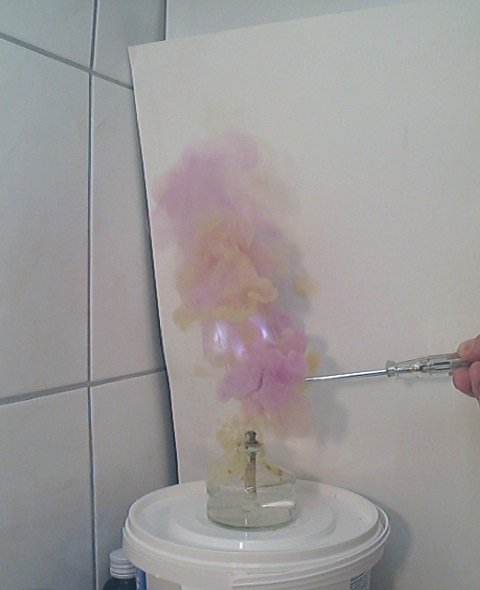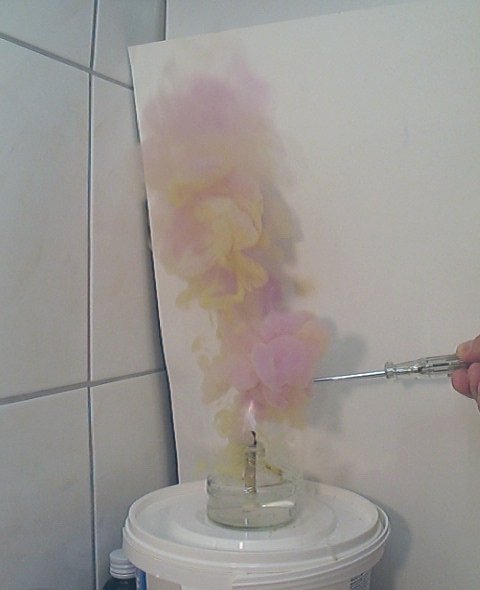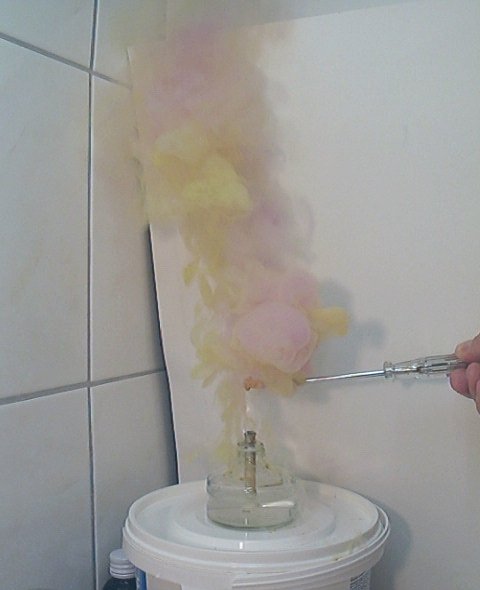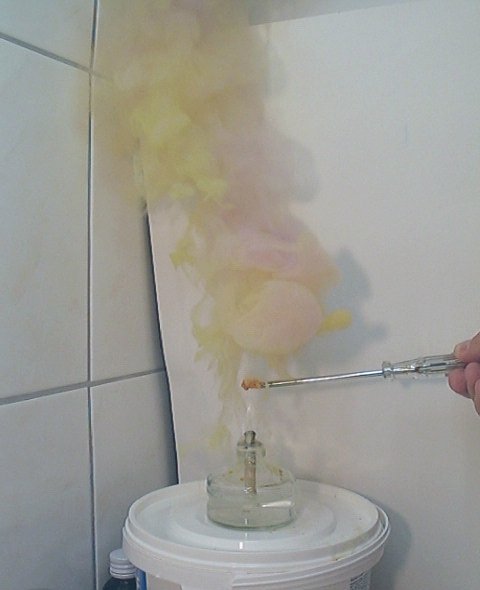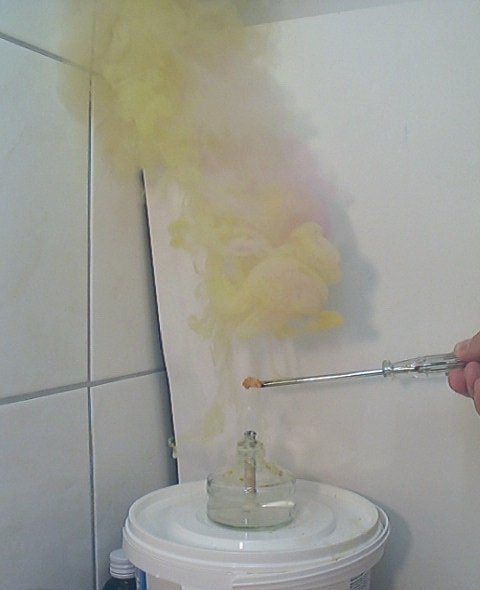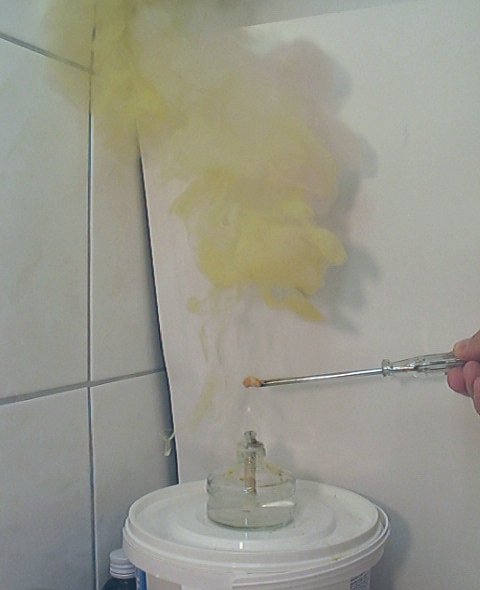


Colored smoke -- yellow and purple
This experiment was not the result of any theoretic reasoning, but it was the result of thinking about uncommon oxidator/reductor mixes and how they could behave. Thiocyanate ion is a fairly strong reductor and periodate is a strong oxidizer. The idea of mixing them and trying to ignite the mix was just an interesting thing to try, but the result was more spectacular than initially imagined.
When ammonium thiocyanate and potassium periodate are mixed and ignited, then the mix burns fairly well, with only a weakly visible flame, but with very remarkable smoke. The smoke first is purple, but it quickly changes color to bright yellow/ochre.
![]()
![]() Required
chemicals:
Required
chemicals:
-
potassium (meta)periodate, KIO4 (sodium metaperiodate also can be used)
-
ammonium thiocyanate, NH4SCN (this chemical is very hygroscopic, reasonably dry material must be used, otherwise the experiment does not succeed).
![]() Required
equipment:
Required
equipment:
-
small burner
-
heat resistant spatula
-
glass jar
-
glass or ceramic rod
![]() Safety:
Safety:
- potassium periodate is a strong oxidizer, keep this out of contact of combustible materials;
- the smoke, produced in this experiment, most likely is toxic, so avoid inhaling this.
![]() Disposal:
Disposal:
- Any solid waste can be flushed down the drain with a lot of water.
![]()
Production of colored smoke
![]() Take a
spatula full of solid potassium periodate and a spatula full of dry ammonium
thiocyanate. Put both chemicals in a small glass beaker, and crush the crystals
and mix the chemicals thoroughly with a glass rod (no plastic or metal should be
used, these are corroded or stained by the mix). After mixing, a fine (somewhat clumpy) powder should be obtained. While
mixing, the color of the mix slowly changes from white to light yellow. This is
not a problem.
Take a
spatula full of solid potassium periodate and a spatula full of dry ammonium
thiocyanate. Put both chemicals in a small glass beaker, and crush the crystals
and mix the chemicals thoroughly with a glass rod (no plastic or metal should be
used, these are corroded or stained by the mix). After mixing, a fine (somewhat clumpy) powder should be obtained. While
mixing, the color of the mix slowly changes from white to light yellow. This is
not a problem.
![]() Put some
of the mix on a heat-resistant spatula and keep this in the flame of a small
burner. The mix will ignite, with production of a thick purple cloud of smoke.
Soon, however, the smoke changes color from purple to yellow. There also are
faint 'flames', with a purple color.
Put some
of the mix on a heat-resistant spatula and keep this in the flame of a small
burner. The mix will ignite, with production of a thick purple cloud of smoke.
Soon, however, the smoke changes color from purple to yellow. There also are
faint 'flames', with a purple color.
The result of the ignition and the smoke produced are shown in the series of 9 pictures, given here. By clicking on a picture you can obtain a larger resolution image.
The 9 pictures cover a period of time of approximately 1 second. A video of this reaction can be downloaded here: colored_smoke.avi. Download size is just over 1.5 MByte.
Two other videos were made. One in real time, the other in slow motion. Download size of these videos is approximately 1 MByte each.
![]()
Capturing and analysis of smoke
![]() The experiment was repeated and some of the smoke was captured in a glass jar. This was done, by putting a
small pile of
the mix of potassium periodate and ammonium thiocyanate on a spatula and then
putting this under a glass jar and putting all this above a small burner.
Immediately, when the mix ignited, the jar was placed tightly on its lid in
order to keep the smoke inside. Most of the smoke could be captured in this way.
A picture of the captured smoke is given below. The air inside the jar is loaded
with yellow
smoke. Its inside walls are dry and clean.
The experiment was repeated and some of the smoke was captured in a glass jar. This was done, by putting a
small pile of
the mix of potassium periodate and ammonium thiocyanate on a spatula and then
putting this under a glass jar and putting all this above a small burner.
Immediately, when the mix ignited, the jar was placed tightly on its lid in
order to keep the smoke inside. Most of the smoke could be captured in this way.
A picture of the captured smoke is given below. The air inside the jar is loaded
with yellow
smoke. Its inside walls are dry and clean.
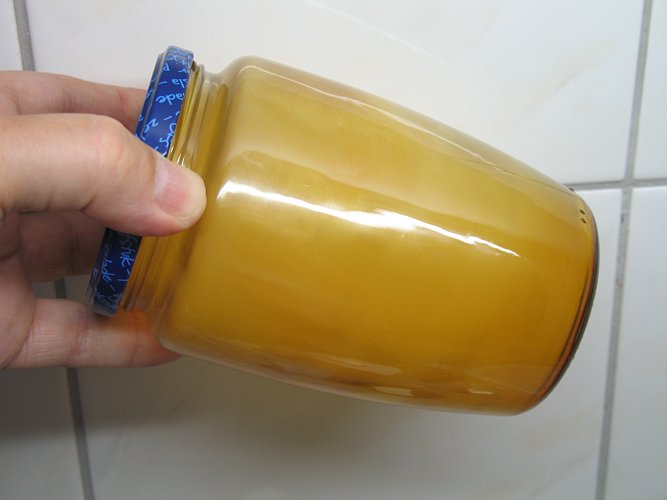
The jar with smoke was allowed to stand for 5 minutes or so. In that time, most of the smoke settled at the bottom. The air inside became clearer again, and at the bottom many reddish droplets collected. The next picture shows the bottom of the glass jar, with many red droplets.
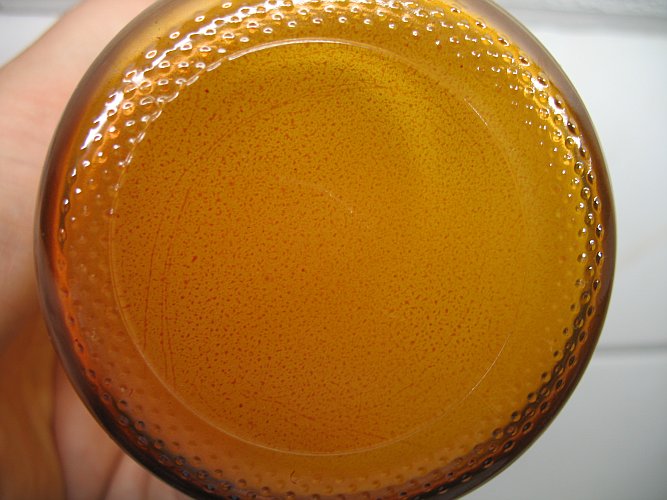
![]() When
most of the smoke had settled at the bottom and the lower part of the glass
walls, some water was put in the jar. The walls and the bottom immediately were
cleaned by the water, and the material dissolved at once. A bright yellow
solution was obtained. The color of this bright yellow liquid, however, quickly
faded to pale yellow. The liquid is slightly turbid. One cannot speak of a true
precipitate, but there is some turbidity. Most of the smoke, however, simply
dissolves and only a tiny fraction consists of insoluble matter. If most of it
were insoluble matter, then the liquid, obtained after adding water, would be
completely turbid.
When
most of the smoke had settled at the bottom and the lower part of the glass
walls, some water was put in the jar. The walls and the bottom immediately were
cleaned by the water, and the material dissolved at once. A bright yellow
solution was obtained. The color of this bright yellow liquid, however, quickly
faded to pale yellow. The liquid is slightly turbid. One cannot speak of a true
precipitate, but there is some turbidity. Most of the smoke, however, simply
dissolves and only a tiny fraction consists of insoluble matter. If most of it
were insoluble matter, then the liquid, obtained after adding water, would be
completely turbid.
The two pictures below show the pale yellow and slightly turbid liquid. This picture was made, after the fading of the yellow color completed. This is the final color.
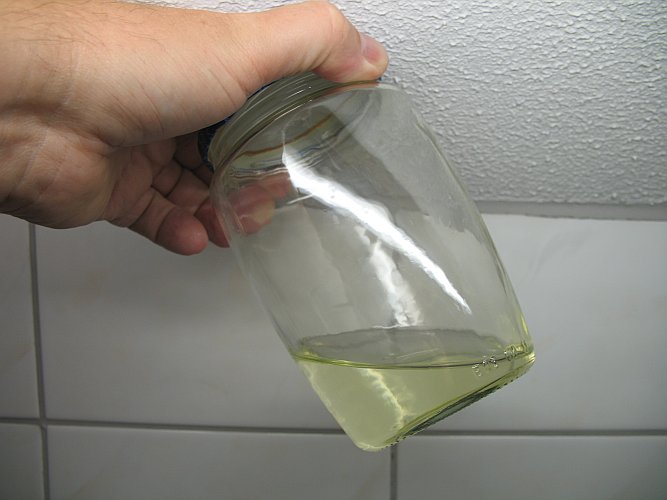
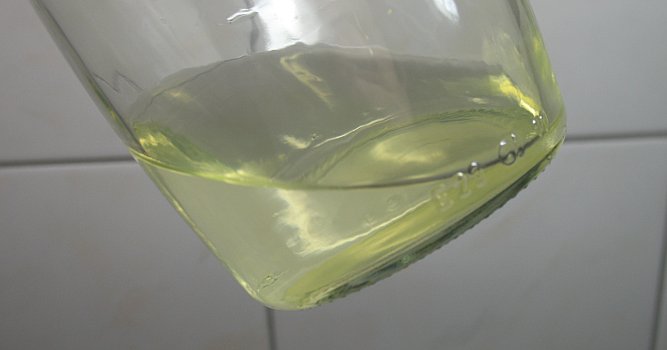
![]() Part of
the liquid was poured in an erlenmeyer and a small amount of 20% sulphuric acid
was added. This results in change of color. The liquid becomes bright
yellow/ochre and it also seems to become even less turbid. The change of color
takes only ten seconds or so. The picture below nicely shows the contrast
between the original liquid and some acidified liquid.
Part of
the liquid was poured in an erlenmeyer and a small amount of 20% sulphuric acid
was added. This results in change of color. The liquid becomes bright
yellow/ochre and it also seems to become even less turbid. The change of color
takes only ten seconds or so. The picture below nicely shows the contrast
between the original liquid and some acidified liquid.
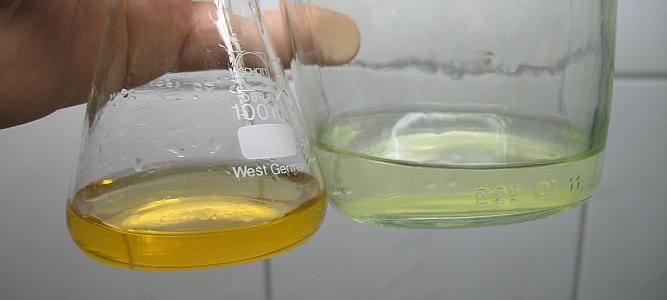
![]() When a small amount of hydrogen peroxide is added to the yellow/ochre
liquid, then its color becomes slightly more intense, but the effect hardly is
noticeable. No additional picture is made of this, it just looks like the liquid
in the erlenmeyer, shown above, just a tad darker.
When a small amount of hydrogen peroxide is added to the yellow/ochre
liquid, then its color becomes slightly more intense, but the effect hardly is
noticeable. No additional picture is made of this, it just looks like the liquid
in the erlenmeyer, shown above, just a tad darker.
![]() When some sodium sulfite is added to the yellow/ochre liquid,
then its color quickly fades and it only becomes very pale yellow. The picture
below shows the result of adding a slight excess of sodium sulfite to the
yellow/ochre liquid, shown above.
When some sodium sulfite is added to the yellow/ochre liquid,
then its color quickly fades and it only becomes very pale yellow. The picture
below shows the result of adding a slight excess of sodium sulfite to the
yellow/ochre liquid, shown above.
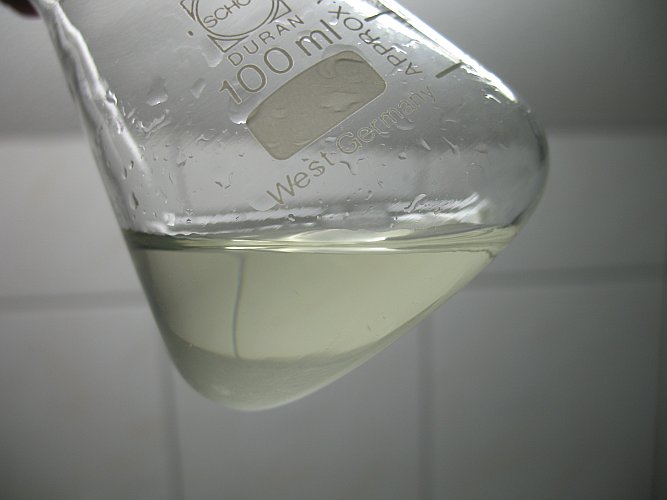
This liquid is very pale yellow and slightly turbid.
![]() Some
further analysis of the light yellow original liquid (without adding acid or
sodium sulfite) was performed. Its acidity was determined. The liquid appears to
be near-neutral, no significant acidity, nor any significant alkalinity. Also,
some lead nitrate was added to the liquid. This does not result in formation of
a bright yellow precipitate, so no iodide was present. Also after adding a
solution of Na2SO3 in dilute HNO3 (1 M) still
no yellow precipitate of PbI2 is created, so also no higher oxidation
state iodine species are present in the smoke (at least not in decent
quantities).
Some
further analysis of the light yellow original liquid (without adding acid or
sodium sulfite) was performed. Its acidity was determined. The liquid appears to
be near-neutral, no significant acidity, nor any significant alkalinity. Also,
some lead nitrate was added to the liquid. This does not result in formation of
a bright yellow precipitate, so no iodide was present. Also after adding a
solution of Na2SO3 in dilute HNO3 (1 M) still
no yellow precipitate of PbI2 is created, so also no higher oxidation
state iodine species are present in the smoke (at least not in decent
quantities).
![]()
The ashes, solid remains
The burning mix of potassium periodate and ammonium thiocyanate also leaves quite some solid remains on the spatula. These can be regarded as the ashes of the burning mix. This residue is bright yellow/ochre, just like the smoke.
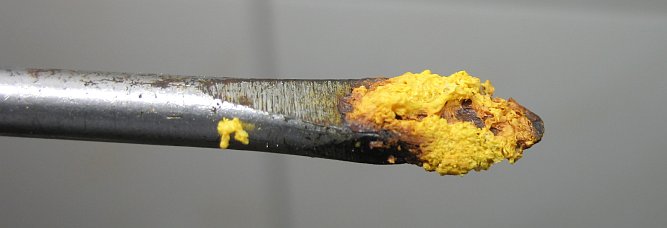
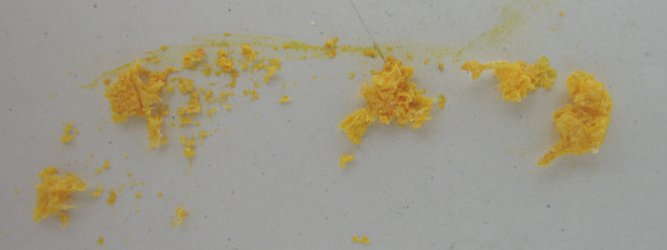
When this yellow solid is added to water, then it does not dissolve. Even after a few days, the liquid still is colorless and the yellow solid sits at the bottom.
![]()
Discussion of results
![]() It is not easy at all to give precise equations, which
describe the reactions in this experiment. Initially, when the mix of potassium
periodate (KIO4) and ammonium thiocyanate (NH4SCN) is
heated, then the periodate decomposes or reacts with thiocyanate, giving
elementary iodine. This elementary iodine gives purple clouds at the relatively high
temperatures involved.
It is not easy at all to give precise equations, which
describe the reactions in this experiment. Initially, when the mix of potassium
periodate (KIO4) and ammonium thiocyanate (NH4SCN) is
heated, then the periodate decomposes or reacts with thiocyanate, giving
elementary iodine. This elementary iodine gives purple clouds at the relatively high
temperatures involved.
![]() The
ammonium thiocyanate can be regarded as combustible matter. It is rich in
hydrogen, sulphur and carbon, all of which can be oxidized very well by the
oxygen, released from the potassium periodate. Most likely, quite some water is
produced, sulfate is produced and carbon dioxide is produced. Other partially
oxidized species may be present as well in the smoke.
The
ammonium thiocyanate can be regarded as combustible matter. It is rich in
hydrogen, sulphur and carbon, all of which can be oxidized very well by the
oxygen, released from the potassium periodate. Most likely, quite some water is
produced, sulfate is produced and carbon dioxide is produced. Other partially
oxidized species may be present as well in the smoke.
The main reaction may be something as follows:
2KIO4 + NH4SCN → K2SO4 + CO2 + 2H2O + I2 + N2
There certainly are, however, many side reactions. Most likely, there also will be formation of iodide, sulphur, sulphur dioxide, carbonates and all kinds of partially oxidized compounds, derived from ammonium thiocyanate. Most striking is the formation of copious amounts of a yellow compound (or maybe two different yellow compounds). It might even be that the reaction, given above, is not the main reaction, but the reaction in which the yellow compound is formed may be the main reaction.
![]() The experiment shows that the purple color of the iodine is
not simply diluted and fades away, but it changes from purple to yellow. Clouds,
which first are purple quickly change color to yellow. No fully satisfactory
explanation can be given as of now for the observed phenomena. It is almost
certain that the initial purple color is caused by iodine vapor. The change of
color from purple to yellow can be caused by two things:
The experiment shows that the purple color of the iodine is
not simply diluted and fades away, but it changes from purple to yellow. Clouds,
which first are purple quickly change color to yellow. No fully satisfactory
explanation can be given as of now for the observed phenomena. It is almost
certain that the initial purple color is caused by iodine vapor. The change of
color from purple to yellow can be caused by two things:
- The color of the smoke is yellow from the start, but the strong purple color of the iodine vapor masks the yellow color. The iodine vapor quickly spreads out in the air, and is not visible anymore very soon, while the yellow smoke remains visible for a much longer time. Macroscopic solid particles are diffusing away much more slowly.
- The purple color of the iodine disappears, due to a reaction with a compound in the smoke, while remains of iodine
Explanation (1) seems most plausible, because with lead nitrate no iodide could be detected in the dissolved captured smoke.
![]() The yellow smoke certainly is not sulphur. The color of
finely divided sulphur is different (less bright, and also it has a different
hue, less ochre, more pure yellow). The high solubility in water also rules out
sulphur as the main component of the smoke. If there is sulphur in the smoke,
then it only is a very small fraction. The solution of the smoke in water only
is very slightly turbid. If a large fraction of the smoke consisted of elementary sulphur, then the liquid obtained after
adding water would be much more turbid.
The yellow smoke certainly is not sulphur. The color of
finely divided sulphur is different (less bright, and also it has a different
hue, less ochre, more pure yellow). The high solubility in water also rules out
sulphur as the main component of the smoke. If there is sulphur in the smoke,
then it only is a very small fraction. The solution of the smoke in water only
is very slightly turbid. If a large fraction of the smoke consisted of elementary sulphur, then the liquid obtained after
adding water would be much more turbid.
![]() I have
not the faintest idea of the nature of the yellow solid. It also seems that the
yellow solid in the smoke is of a different nature than the yellow ashes:
I have
not the faintest idea of the nature of the yellow solid. It also seems that the
yellow solid in the smoke is of a different nature than the yellow ashes:
- By far the largest fraction of the yellow solid in the smoke is soluble in water, giving a pale yellow solution.
- The yellow solid in the ashes is insoluble. The ashes contain quite some iodine and iodide, which can be removed by rinsing with water, but what remains is a totally insoluble bright yellow solid, which even after two days of standing in a test tube with water does not change. No change of color, no dissolving. The liquid above the solid is colorless (or very pale yellow).
